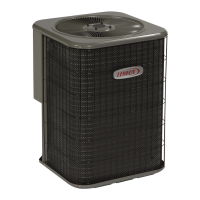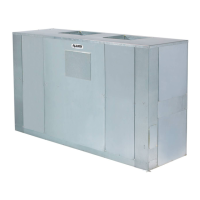
Do you have a question about the Lennox TSA S4 Series and is the answer not in the manual?
| Brand | Lennox |
|---|---|
| Model | TSA S4 Series |
| Category | Industrial Equipment |
| Language | English |
Detailed specifications for unit models including dimensions, connections, and components.
Electrical specifications including voltage, overcurrent protection, and motor amp ratings for various unit models.
Provides a table correlating model numbers with their physical dimensions (A and B) in inches and millimeters.
Describes the control box and its function in managing unit operations and connections.
Explains the role of the compressor contactor in energizing the compressor based on thermostat demand.
Details the PSC fan motor and its associated run capacitor, including access for servicing.
Describes the function and location of the high-pressure safety switch that protects the compressor.
Explains the auto-reset loss of charge switch and its role in shutting off the compressor.
Details the crankcase heater's function in preventing liquid slugging and its control mechanism.
Explains the purpose and replacement requirement of the filter drier for system moisture removal.
Introduces the scroll compressor design, its efficiency, and basic operational principles.
Lists recommended torque values for various fasteners encountered during service and repair.
Provides guidance on selecting and using manifold gauge sets suitable for HFC-410A systems.
Explains the purpose and operation of liquid and vapor line service valves for system manipulation.
Details the steps for safely accessing the service port on angle and ball type service valves.
Describes the procedure for opening and closing angle-type service valves.
Describes the procedure for opening and closing ball-type service valves.
Instructions for correctly reinstalling the stem cap to maintain system seals after service.
Procedure for recovering HCFC-22 refrigerant when the unit lacks shut-off valves or is not operational.
Procedure for recovering HCFC-22 refrigerant when the unit has manual shut-off valves.
Guidelines for installing the unit on a ground-level slab, considering elevation and water drainage.
Recommendations for installing the unit on a roof, including support and clearance requirements.
Information on selecting and installing refrigerant line sets, including Lennox L15 series.
Discusses considerations for matching the unit with indoor coils and line sets, especially regarding oil types.
Illustrates proper isolation techniques for refrigerant lines transitioning between vertical and horizontal runs.
Shows methods for isolating vertical refrigerant line runs, including insulation requirements.
Illustrates methods for isolating horizontal refrigerant line runs using strapping and hangers.
Instructions for preparing refrigerant line ends for brazing, ensuring a clean and round cut.
Describes the process of removing service port caps and cores before brazing connections.
Details how to connect the manifold gauge set and nitrogen cylinder for brazing procedures.
Instructions for protecting service valves from heat damage during brazing operations.
Guidance on brazing refrigerant lines, including turning off nitrogen flow and flame direction.
Instructions for reinstalling service port caps after brazing and evacuation procedures.
Steps for removing a fixed orifice metering device from the indoor coil assembly.
Procedure for removing and replacing an expansion valve, including equalizer line disconnection.
Detailed procedure for flushing the line set and indoor coil with clean refrigerant.
Describes connecting the gauge set for leak testing the line set and indoor coil.
Outlines the steps for pressurizing the system with nitrogen and checking for leaks.
Instructions for connecting the gauge set and vacuum pump for system evacuation.
Details the procedure for evacuating the system to the required micron level and breaking vacuum.
Guidance on selecting and installing the correct disconnect switch and wiring for the unit.
Information on using the transformer provided with the indoor unit for low-voltage control power.
Recommendations for installing the room thermostat, including location and placement guidelines.
Instructions for routing and securing high voltage and ground wires for safe installation.
Details on running 24VAC control wires and making thermostat connections.
Illustrates typical low voltage wiring connections between the thermostat, indoor, and outdoor units.
Outlines the procedure for servicing units that are delivered without refrigerant charge.
Steps involved in starting up the unit after installation, including checks and initial operation.
Introduces procedures for connecting gauge sets, checking/adjusting airflow, and managing refrigerant.
Explains the Delta-T process for checking and adjusting indoor airflow for optimal system performance.
Illustrates the decision process for selecting the correct refrigerant charging method.
Details the weigh-in method for charging refrigerant based on line set diameter and length.
Provides instructions for using the weigh-in method to charge refrigerant, considering outdoor temperature.
Explains the subcooling method for checking and adjusting refrigerant charge based on liquid line temperature.
Describes the function and trip point of the auto-reset high pressure switch.
Outlines maintenance checks for the outdoor unit, including fan motor and connections.
Provides instructions for cleaning the outdoor coil, considering environmental factors.
Lists maintenance tasks for the indoor unit, such as filter changes and blower checks.
Maintenance steps for the indoor coil, including cleaning and checking condensate lines.
Fields for recording job details, installer, unit model, serial number, and nameplate voltage.
Checklist items for electrical connections, voltage, pressures, airflow, and refrigerant charge verification.
Checklist items for verifying service valves, thermostat calibration, settings, and level.












